 |  |
By Greg Niemann
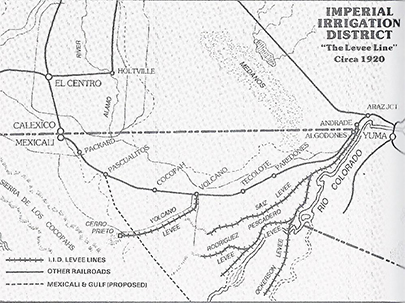
Mexicali, the state of Baja California’s capital and second largest city, was a hot (120+ degree days) barren desert with dust storms and desolation. Not far away, however, was the Colorado River. Early in the 20th century Americans began building canals to divert water west, creating the vast Imperial Valley. The whole area became a fertile agricultural center.
Today’s Mexicali was earlier called La Laguna del Alamo, first settled in 1898 by former miners who left the dwindling pickings at El Alamo near Ensenada to try their luck in the desert.
Going further back, it is known that Juan Bautista de Anza camped near the site in December 1775 on his way north. But the desert was forbidding and for well over 100 years the area was claimed by no one.
One of the American agricultural pioneers, C. M. “Limpy” Holt, was the first to coin California’s “Imperial Valley” name, thinking it projected a more positive image for a difficult and desolate area. But Holt did not stop there. He tinkered with the words California/Mexico, switched some syllables around and came up with names for the towns on opposite sides of the border (Cal-exico and Mexi-cali), and the names stuck, La Laguna del Alamo to be forever called Mexicali.
Water tamed the desert
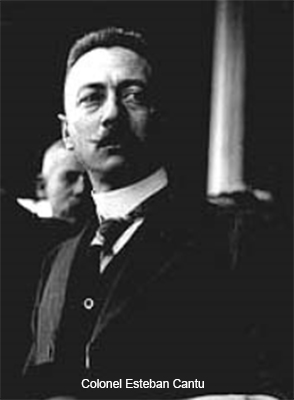
After the Imperial Canal was finished in 1902, Mexicali began to grow as water became available for irrigation. Many of the earliest settlers came to work on the irrigation projects for the Colorado River Land Company, an American company which owned practically all of the land in the valley. The company then leased land for cotton and the workers stayed to cultivate their ensuing crops.
The founding date of Mexicali is March 14, 1903 and Manuel Vizcarra was elected the town’s first Civil Authority. In 1904 Mexican President Porfirio Diaz authorized Mexican canals to divert more water to the Mexican side of the border. A big flood occurred in 1906 as the waters of the Colorado River went over their banks. Levees and dikes were painstakingly reinforced and the planting of cotton, cantaloupes, alfalfa and corn resumed.
The Intercalifornia Railroad, a branch of the Southern Pacific, was built and went south from Calexico, through Mexicali, continued east through Baja California farmland and reentered the United States at Yuma. Not only was it a shorter route from the Imperial Valley to eastern markets, but was able to tap the rich cotton and agricultural areas south of the border.
During the Revolution of 1911, soldiers of fortune came into Mexicali. Under the banner of an American labor movement, the IWW (Wobblies) tried to make Mexicali a Socialist enclave. They were driven off by the Mexican army but not before lives were lost and numerous wounded. Once the Wobbly leader was shot, the remaining anarchists gave up.
Stability was restored in 1915 by Colonel Esteban Cantu who served as Baja California Norte Governor in 1915-1920. He moved the Baja California territorial capital to Mexicali and was responsible for much of the infrastructure around the entire state.
In 1936, the Colorado River Land Company was ordered by the Mexican government to sell most of its holdings to Mexican farmers and farm communities known as ejidos.
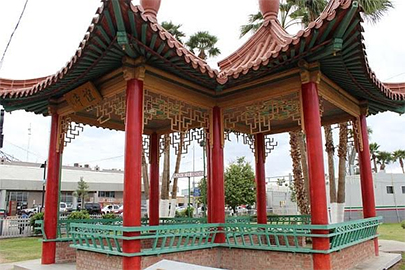
An exemplar of diversity
During the early years of Mexicali's history, the town was an exemplar of diversity with one report listing among the laborers approximately 5,000 Mexicans, 3,500 Chinese, 300 Japanese and 200 Hindus. But it doesn't mean they got along. For example, many Mexicans blamed the Chinese for taking ‘their’ jobs. Sound familiar?
There is still a large Chinese population, one of the largest concentrations per capita outside Asia. You can find excellent Chinese food among the reported 200 Chinese restaurants in the capital city.
Today’s Mexicali covers 5,254 acres and is home to about 700,000 inhabitants, or right at 1,000,000 people if you count the surrounding area. The city maintains a highly educated and skilled population, having modernized to become an important population center.
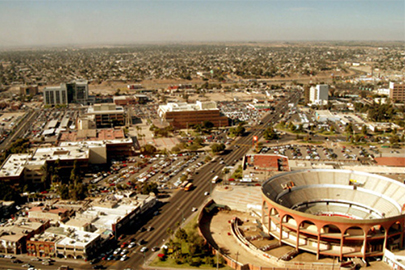
While historically an agricultural economy, today Mexicali has gradually embraced other industries. Mexicali pioneered the aerospace industry in Mexico, when Rockwell Collins, (formerly Hughes Tool Company) decided to established an operation there in 1966, becoming the oldest company under the maquiladora program nationwide.
Since then many other companies, such as Honeywell, Gulfstream, SunPower, Mitsubishi, Autolite, Nestlé, Coca Cola, and Goodrich Corporation have built maquiladora plants in the city.
In 1986 Mexicali achieved international recognition with a meeting between then Mexican President Miguel de le Madrid and U.S. President Ronald Reagan. The huge sand dunes to the east of the city have become an attraction unto themselves. Sandboarding has become big in the Algodones dunes. In fact, the 2016 Continental Sandboarding Cup will be held there in March, (3-21-22, 2016) attracting the sport’s best athletes from countries like Peru, Switzerland and Brazil to tackle the massive mountains of sand.
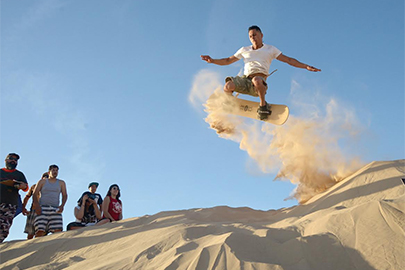
Earlier this year I crossed the border at Mexicali and noticed a large construction project underway just south of the border on the right, confirming continuation of an expanding economy.
Gringos most often just drive through Mexicali on their way to San Felipe or other points south, and that’s a shame. Along with great Chinese food, there are a number of good, inexpensive hotels to choose from, including the Fiesta Inn and Real Inn Mexican chains. Even the popular five-star Hotel Lucerna is still less than $100 a night. That iconic hotel with a cascade falling into the pool has been there a long time too, as we stayed there back in the 1980s.
Mexicali is an interesting city, hugging the international border on the north, and continuing to sprawl in the other directions. On my last visit I made a wrong turn and found myself in a suburban area I never knew existed. But we found a great restaurant on our impromptu detour.
Mexicali is unique: farmers, ranchers, factory workers, merchants and politicos work side by side to keep it a viable city. It still seems a little weird, though, to cross the border into Mexico and order dim sum instead of tacos.
About Greg
Greg Niemann, a long-time Baja writer, is the author of Baja Fever, Baja Legends, Palm Springs Legends, Las Vegas Legends, and Big Brown: The Untold Story of UPS. Visit Greg's website.